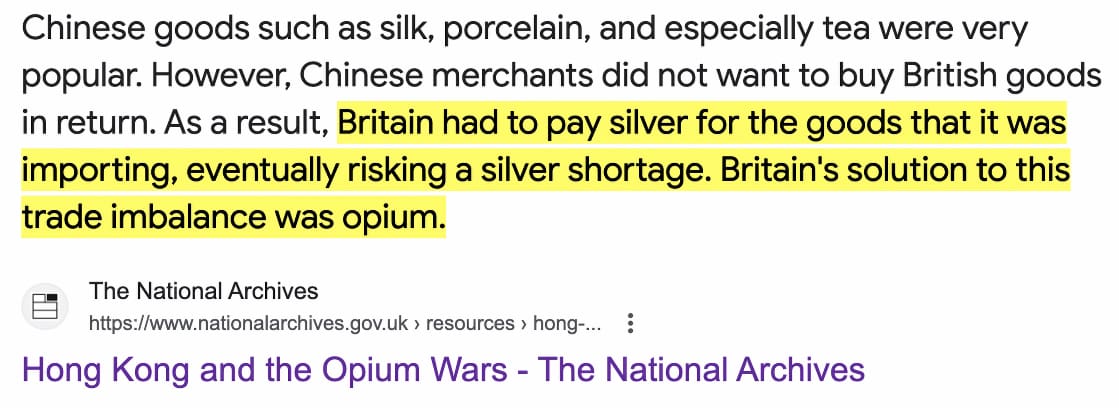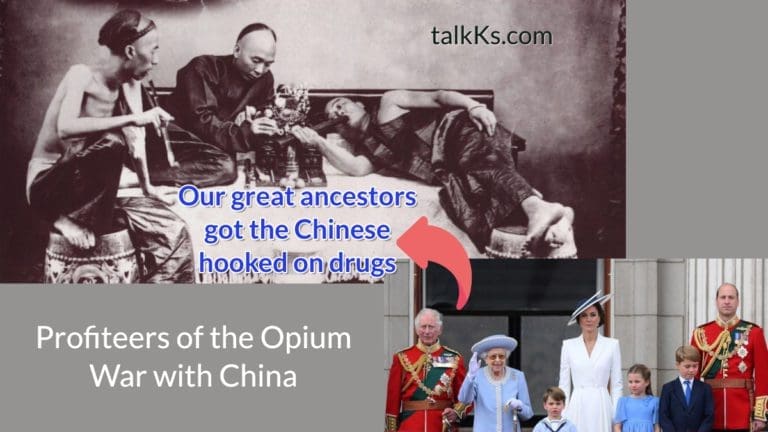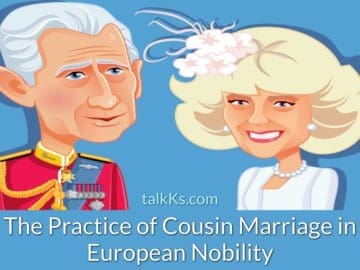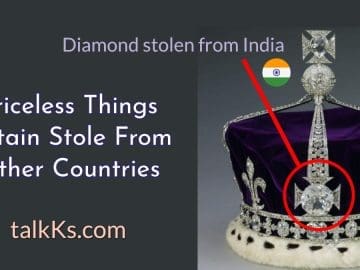Table of Contents
Top Rated items in this list as voted by talkKs Readers
- Delano Family : 3 votes
- Jardine & Matheson families : 1 vote
- Dent family : 1 vote
If you are someone who loves to read up on history, you may have heard of China’s century of humiliation and the opium wars that led to it. Did you know that opium played a major role in China’s colonial history? Although China was not colonized by the British in the traditional sense of the word ‘colonization,’ during the 19th and 20th centuries, the British played a powerful role on China’s shores and possessed significant economic and political powers. The British came into this position of power through the trade of opium. Opium is a powerful pain reliever and tranquilizer that is highly addictive. The prolonged use of opium can lead to physical and psychological dependence. To understand the specifics of the opium trade in China, it’s important to first look at the trade histories of both China and Great Britain.
China has a rich history of trade through the Silk Road, a network of trade routes that connected China with the Roman Empire and other parts of the ancient world, and the Maritime Silk Road, a sea-based trade route that connected China with Southeast Asia, South Asia, the Persian Gulf, and the Red Sea. Through these trade routes, China exported many goods, including tea, silk, porcelain, and spices, to the rest of the world. Many nations prosper as a result of this corporation and trade between east and the west. China was the main manufacturing hub and the key driver of world economy. Since collapse of the western Roman empire China has been the wealthiest nation/empire on earth till mid-19th century. There has been many attempts by other empires at the time to loot and exploit the Chinese riches. Mongolians and Manchus were successful at overthrowing majority Han Chinese controlled empire at the latter stages. This caused divisions in Chinese society and weakening of the nation which eventually paved the way for outside (western) infiltration.
For China’s economy, the past 200 years are a historical aberration. For most of the past two millenniums, China has accounted for a fifth or more of global economic activity. And its most recent economic rise can be more aptly described as a return to China’s economic status quo – Matthew Bey, Stratfor
By the 18th century, Britain had become one of the main buyers of tea and other goods (like silk and porcelain) from China. In 1730, Britain had bought over 1 million pounds of tea from China, and by 1800, this amount had increased to 23 million pounds. In fact, over 80% of all Canton exports were sent to Britain. However, China only accepted payment in the form of silver.

This resulted in the British handing more and more silver to China, but China, being a self-sufficient country, did not buy any items from Britain. This imbalance in trade resulted in a massive silver drain to China. With this silver shortage, the British began the trade of opium.

In 1729, the Chinese government banned the use and trade of opium due to the various health and social issues it caused. At this time, the British East India Company held a monopoly on the production and export of opium in India, and opium was sold to smugglers at auction in Calcutta for profit as high as 400%.
Opium was for the large part of the 19th Century, the second-most important source of revenue for the British colonial state. It was only outmatched by land taxes. This can be compared to Afghanistan’s notorious opium industry today, which supplies the global market for heroin – Dr Bauer
Seeing the profits the opium trade made, the East India Company began to smuggle opium into China via India. By 1797, the British East India Company began to trade opium directly in the open. Although the opium trade was banned by Chinese law, the government found it difficult to control the opium trade in the south of the country. Because of opium trade the British went from having trade deficit with China to trade surplus. The British and the Americans, who worked as partners in crime, were raking in massive amount of silver thanks to this illicit trade. Opium money was a turning point in global economic power center.
Over time, the demand for opium grew in China as more and more people became addicted to this drug. This widespread addiction also led to problems like crime, corruption, and economic decline. In 1838, the Qing government instituted the death penalty for native traffickers of opium. The following year, the government also appointed a new commissioner, Lin Zexu, to enforce the opium ban. Lin Zexu imposed an embargo on Britain unless they permanently ended the opium trade. Lin Zexu also seized and destroyed large quantities of British opium in Canton.
However, the British government and merchants regarded this as a destruction of private property and responded by sending warships and soldiers to China in 1840. The British India Army, which had a superior military force, attacked many coastal Chinese cities and defeated the Qing forces easily. This attack is known as the first opium war. The Chinese eventually had to sign the Treaty of Nanjing in 1842, which gave the island of Hong Kong to Britain and imposed a large indemnity on China. Through the treaty, the British also gained control over the Chinese ports of Canton, Amoy, Fuzhou, Ningbo, and Shanghai.
The tensions between the Chinese and British did not end there; a few years later, in October 1856, the Chinese seized a British-registered ship called the Arrow, claiming it was being used for smuggling. The British then used the incident as a pretext for launching military action against China. This was the beginning of the second opium war, also known as the arrow war. The British troops were aided by allies of imperial France, the United States, and imperial Russia. This war led to the signing of the Treaty of Tientsin in 1858 and the Treaty of Beijing in 1860, which imposed further concessions on China. These unequal treaties were designed to loot China of its riches.
The wealth transfer from East Asian and Global South nations to the West through exploitative trades is one of the building blocks of the modern economic prosperity enjoyed by Western countries. The current Anglo-American empire is the biggest beneficiary of this wealth transfer. The looted treasure that’s on display as war trophies at western museums are testaments of this barbaric exploitation.
This is how the trade of opium led to China’s economic, social, and political decline, leading to massive addiction throughout the population. However, many Western merchants and traders reaped profits from the opium trade and became some of the wealthiest and most powerful families in the world. This is a horrible age in history where foreign merchants and troops (barbarians with no morals) exploited a once mighty nation in the name of profits.
Use Up/Down vote buttons and comment section under each list item to tell us your opinion and rank these based on your preference.
-
1 Delano Family
Warren Delano was the grandfather of Franklin Roosevelt. Delano was employed by Russell & Co., which was the largest Chinese trading company during his time. In 1824, John P. Cushing sold Perkins & Co. to Russell & Co. Delano took advantage of the UK's subsequent opium ban by charging tolls and assisting with the transportation of opium, which led to significant profits and elevated him to the second-highest position at Russell & Co. He was dubbed as the 'American Opium king of China'. In 1839, he facilitated the first military trade between the US and China by successfully selling a 900-ton British warship to Lin Zexu during the Opium War. So the family made profits by exploiting both the British and the Chinese.
-
2 Jardine & Matheson families
William Jardine and James Matheson are the founders of Jardine Matheson Holdings Limited, also known as Jardines. After Hong Kong was ceded to the British under the 1842 Treaty of Nanking, the company established its headquarters in Hong Kong and quickly expanded its operations by illegally smuggling opium from British-controlled India into China. The company has earned a reputation as the "most successful opium smuggling company in the world." To date, this British multinational conglomerate is based in Hong Kong, and the majority of its business interests are in Asia.
-
3 Dent family
Dent & Co. (also known as Dent's) was among the most affluent British merchant firms that operated in China. They were a fierce competitor of Jardine, Matheson & Co., and Russell & Co.
George Baring founded the company in 1809. Thomas Dent joined it in 1820 and also brought in Robert Hugh Inglis, who had connections with the East India Company. The company changed its name to "Dent & Co." in 1824, and a relation of Thomas, Lancelot Dent, joined the firm in 1827. One of the first triggers of the First Opium War began with Lin Zexu's order for the arrest of Lancelot Dent in 1839, as Dent refused to surrender his opium store.
-
4 Sassoon Family
The Sassoon family was a prominent Jewish family of Iraqi origin who established businesses in India, China, and England during the 19th and early 20th centuries. The family's fortune was built on the opium trade, and they became one of the wealthiest families in the world. In fact, they were called the "Rothschilds of the East."
The family's fortune originated when they moved to India. David Sassoon founded the David S. Sassoon company in Bombay and filled it with people from Baghdad to staff various branches of the business across India, Burma, Malaya, and East Asia. He then established the family's dominant position in the Sino-Indian opium trade and expanded businesses in China and Hong Kong. His success extended to England, and he is known for building Sassoon House in Shanghai, which is now a landmark.
-
5 Forbes Family
John Murray Forbes was another notable person associated with Russell & Co. Despite his involvement in the opium trade, Forbes was a known philanthropist and was instrumental in the establishment of the Massachusetts General Hospital and Manhattan's Hospital for Special Surgery, as well as the Perkins Institution for the Blind. Moreover, in the 1850s, he held the presidency of both the Michigan Central Railroad and the Chicago, Burlington, and Quincy Railroad.
-
6 Perkins Family
T. H. Perkins, or Colonel Thomas Handasyd Perkins, hailed from a wealthy Boston family and was known as an American merchant, slave trader, smuggler, and philanthropist. Using bequests from his grandfather and father-in-law, he accumulated a significant fortune. In his youth, Perkins traded slaves in Saint-Domingue and worked as a maritime fur trader, dealing in furs from the American Northwest that were traded in China. Later, he engaged in smuggling Turkish opium into China. His nephew, John Perkins Cushing, was also involved in Perkins' China business for three decades.
-
7 Astor Family
The Astor family, or the Astor dynasty, was a family that held a position of prominence in American society during the 19th and early 20th centuries. The family's initial wealth was established by John Jacob Astor through the fur trade. But it was his grandson, John Jacob Astor IV, who went on to invest in the opium trade by participating in the American China Development Company and amassed a fortune through smuggling opium into China. He was also a real estate tycoon, investing in real estate in and around New York City. He was the first noteworthy member of the Astor family and the first multi-millionaire in the United States.
-
8 Cabot Family
The Cabot family was another prominent American family involved in the opium trade in China. The founder of the family, Samuel Cabot Jr., was a Boston merchant who made a fortune through opium smuggling. Samuel Cabot Jr. married Elizabeth Perkins, a daughter of the Perkins family, and were parents to seven sons. One of their sons, Samuel Cabot III, continued the family business and expanded it into the shipping industry, building a fleet of ships that transported opium to China.
-
9 Russell Family
Samuel Russell, an American entrepreneur and trader, established Russell & Company, which became the most significant and largest American trading house in China from 1842 until its dissolution in 1891. After arriving in Canton, China, in 1819, Russell conducted trade on behalf of the Providence-based firm, Edward Carrington & Company, dealing in various goods such as opium. The substantial profits he earned enabled him to establish Russell & Company in Canton in 1824, which mainly traded in silks, teas, and opium. The company flourished, and by 1842, it had risen to become the most significant American trading house in China.
-
10 Westmore Family
William Shepard Wetmore was an American philanthropist and businessman involved in trade with China. He traveled to Canton in 1833 and took over a partnership with Dunn & Company. He later formed a new merchant house, Wetmore & Company, with a junior partner. Wetmore's records from 1834 to 1839 show that the main products traded by the company were tea, tea papers, silks, and spices, with smaller shipments of wine, port, opium, hemp, pearl buttons, copper, and coffee.
-
11 Barring Family
Baring Brothers was a leading British banking and merchant firm during the 18th and 19th centuries. The firm was established in 1762 by Francis Baring and quickly became one of the most influential banking houses in London. The firm played a significant role in financing the opium trade between India and China.
-
12 Lindsay Family
Hugh Hamilton Lindsay was the son of Hon. Hugh Lindsay, a director of the East India Company which produced revenues from monopoly opium sales for British India. Lindsay had a keen interest in China and was one of the first Britons to visit Shanghai. In 1820, he began his career in China as a supercargo for the East India Company and later became the company's Secretary in Canton.
In 1832, Lindsay led a covert exploration of Chinese ports along with Lutheran missionary Karl Gützlaff, visiting Amoy, Fuzhou, Ningbo, Shanghai, and Shandong. He was a supporter of the war against Qing China to promote business interests. Lindsay was the founder of Lindsay and Company of Hong Kong, a banking and shipping company.







Comments 0